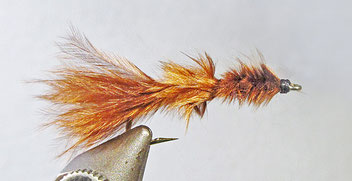Text and images by Craig Smith
(Originally posted in 2018. Updated with much appreciated information from Forrest Oldham.)

Many fly tyers enjoy the process of tying flies than involve multiple materials and steps, but sometimes we like to tie effective flies very quickly. Flies that can be tied quickly with minimal materials are often referred to as “guides” flies since they can be tied in large numbers with a minimal investment in time and can put clients onto fish in many angling conditions.
Leech patterns are effective for many freshwater species in streams and stillwaters. There must be hundreds of leech patterns that have been described in books and on the web, as well as are available as commercial ties. The majority of leech patterns are simple ties, but one variety that I was introduced to about two decades ago may be the simplest of all.
I used to be a frequent guest at the Clearwater House on Hat Creek lodge in Cassel, California. It was there that proprietor and guide Dick Galland introduced me to the Monroe Leech.
I have no idea who the “Monroe” that originated the fly was; I never thought to ask at the time.
Thanks to fly angler and author Forrest Oldham, I have learned that this pattern was originated by Mike Monroe, who guided and operated "The Fly Hutch" shop in Sacramento for many years. This pattern employs just two materials: thread and marabou.
On the first morning that I tied this fly on I caught a half dozen trout swinging it on an intermediate line on Hat Creek, a spring creek that can be very challenging to fish successfully. A couple of days later I caught several fish with it on the Fall River. Since then I have caught countless trout, bluegill, crappie, largemouth bass, and even a few channel catfish in streams, ponds, and lakes up and down California. The Monroe Leech also makes a great damselfly nymph imitation. Depending on the conditions, it can be fished on floating, intermediate, sink tip, and sinking fly lines. I tie it on hooks ranging from size 12 up to size 6. To date I have used black, olive, brown, cinnamon, and purple marabou. If you need a quick-to-tie leechy pattern for your outings, give the Monroe Leech a try.
I also learned from Mr. Oldham that the the instructions I show below for tying the fly were incorrect with respect to the original Mike Monroe design. The original incorporates a copper rib and from notes does not appear to twist the marabou. Click here for a link to a page with an illustration of the original pattern drawn by the late angler, engineer, author, and illustrator John McKim. I hope this link remains available for the foreseeable future. I believe the method shown below, which was shown to me by someone who did production tying for a shop, was an adaptation to remove a couple of steps for a quicker tie.
Materials
| Hook: | Tiemco 200R or equivalent or other 2XL or 3XL nymph hook. |
| Thread: | Any 8/0, 6/0 or equivalent thread |
| Tail and Body: | Marabou, color of choice |
Tying Steps
Step 1: Lay down a thread base. Strip a marabou bunch from the stem. Use enough strands of marabou to make the fly as sparse or full as you like. Tie in with the tips as the tail. Do not trim the rest.
Step 2: Twist the marabou strands into a rope.
Step 3. Wrap the marabou rope forward to just behind the eye and tie off. On longer/larger flies the initial bunch of marabou may not be long enough to reach the hook eye. To fill out the hook shank tie in another bunch of marabou, twist into a rope as in Step 2, and wind to the eye. That’s it!



